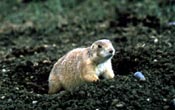Townsend's ground squirrel facts for kids
Quick facts for kids Townsend's ground squirrel |
|
|---|---|
 |
|
| Conservation status | |
| Scientific classification | |
| Genus: |
Urocitellus
|
| Species: |
townsendii
|
| Synonyms | |
|
Spermophilus townsendii Bachman, 1839 |
|
The Townsend's ground squirrel (Urocitellus townsendii) is a type of rodent in the squirrel family. These small creatures live in dry, high desert areas in parts of the United States. They are currently listed as a vulnerable species, meaning their populations need protection.
Contents
Where They Live: Distribution
Townsend's ground squirrels are found in the Great Basin and Columbia Plateau regions. Their home range includes parts of Washington, Oregon, Idaho, Utah, Nevada, and a tiny bit of eastern California.
There are several different types, or subspecies, of Townsend's ground squirrels, each living in slightly different areas:
- Urocitellus townsendii artemesiae – found in south-central Idaho.
- U. t. canus (also called Merriam's ground squirrel) – lives in eastern Oregon, northeastern California, and northwestern Nevada.
- U. t. idahoensis – found in southwestern Idaho.
- U. t. mollis (also known as Piute ground squirrel) – this is the most widespread type, found in eastern California, southeastern Oregon, southern Idaho, western Utah, and Nevada.
- U. t. nancyae – lives in south-central Washington.
- U. t. townsendii – also found in south-central Washington.
- U. t. vigilis – lives in the Snake River Canyon bottomlands of east-central Oregon and west-central Idaho.
These squirrels usually live in dry grasslands and areas with both shrubs and grasses. They like places with plants like big sagebrush, wheatgrass, and rabbitbrush. In some areas, like southeastern Idaho, they prefer spots with certain types of grass and shrubs for their burrows.
Their Favorite Homes: Preferred Habitat
Even though Townsend's ground squirrels live in dry places, they often gather around desert springs and watered fields. They also make their homes on ridgetops, hillsides, valley bottoms, and along canals or old railroad tracks.
Since they dig burrows, these squirrels choose spots with deep, soft, and well-drained soil. In southeastern Idaho, most of their burrows are found in sandy soil.
The amount of space a Townsend's ground squirrel uses, called its home range, can vary. For example, some have a home range of about 1,357 square meters. The number of squirrels in an area can change a lot from year to year.
Life Cycle: Timing of Major Events
Townsend's ground squirrels go into a deep sleep, called estivation, in late spring or early summer when the grasses dry out. They wake up in late winter. This sleep can last for 7.5 to 9 months! It's shorter in wet years because green food is available for longer.
Most female squirrels can have babies when they are one year old. Most males can also breed at one year old, though some males might wait until they are two. Breeding usually happens in late January or early February, right after they wake up from their long sleep.
A mother squirrel is pregnant for about 24 days. They have one litter of pups each year, with 6 to 10 babies in each litter. The pups are born without hair and with their eyes closed. They open their eyes when they are about 19 to 22 days old and are weaned (stop drinking milk) soon after.
Safe Spaces: Cover Requirements
Townsend's ground squirrels live in open areas and use their burrows for shelter, to hide from predators, and to store food. Their burrows are often grouped together in colonies, but some squirrels live alone. Each burrow usually has only one squirrel, except when a mother is raising her pups. Burrows can have one or many openings, plus extra side tunnels.
Sometimes, these squirrels are seen climbing shrubs while looking for food. They might do this to find cover or to spot tasty plants.
What They Eat: Food Habits
Townsend's ground squirrels mainly eat green plants, but they also munch on some seeds and insects. Green grasses are a big part of their diet from late winter until the grasses dry up and the squirrels go into their summer sleep. Before they go into estivation, seeds become very important for getting enough energy.
They eat a lot of winterfat plants if they are available. In eastern Washington, their diet includes a lot of Sandberg bluegrass, western yarrow, and other plants. In southeastern Idaho, crested wheatgrass is a key food. Sometimes, they eat cheatgrass, but it's not a reliable food source because its growth changes a lot each year.
Interestingly, adult Townsend's ground squirrels have sometimes been seen eating young squirrels that haven't been weaned yet.
Who Eats Them: Predators
Townsend's ground squirrels are a main food source for ferruginous hawks and prairie falcons in the Great Basin and Columbia Plateau. They are very important prey for these birds.
Other animals that hunt Townsend's ground squirrels include:
- Other types of hawks and falcons
- Common crows
- Badgers
- Coyotes
- Long-tailed weasels
- Western rattlesnakes
- Gopher snakes
![]() This article incorporates public domain material from the United States Department of Agriculture document "Spermophilus townsendii".
This article incorporates public domain material from the United States Department of Agriculture document "Spermophilus townsendii".


